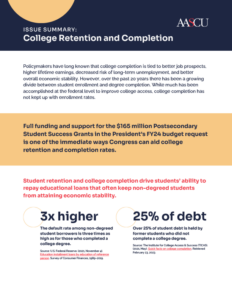Issue Summary
College Retention and Completion
Full funding and support for the $165 million Postsecondary Student Success Grants in the President’s FY24 budget request is one of the immediate ways Congress can aid college retention and completion rates.
Policymakers have long known that college completion is tied to better job prospects, higher lifetime earnings, decreased risk of long-term unemployment, and better overall economic stability. However, over the past 20 years there has been a growing divide between student enrollment and degree completion. While much has been accomplished at the federal level to improve college access, college completion has not kept up with enrollment rates.
Student retention and college completion drive students’ ability to repay educational loans that often keep non-degreed students from attaining economic stability.
3x higher
The default rate among non-degreed student borrowers is three times as high as for those who completed a college degree.
Source: U.S. Federal Reserve. (2021, November 4). Education installment loans by education of reference person. Survey of Consumer Finances, 1989–2019.
25% of debt
Over 25% of student debt is held by former students who did not complete a college degree.
Source: The Institute for College Access & Success (TICAS).(2021, May). Quick facts on college completion. Retrieved February 23, 2023.
Why Is Support Needed?
6 in 10
Today, only six in 10 students who enroll in college will complete a bachelor’s degree within six years.
Source: National Student Clearinghouse (2022, November 29). Completing College National and State Reports. National Student Clearinghouse Research Center.
6% decline vs. increase
Four years after incurring loans, student borrowers who completed a degree show an average balance decline of 6%, compared with a 6% increase for non-completers.
Source: The Institute for College Access & Success (TICAS). (2021, May). Quick facts on college completion.
Case Studies
Florida International University (FIU)’s Scaling Completion Initiative (SCI)
At FIU, out of 138,399 distinct students during 2017–2021, 11.6% that attended stopped out. SCI was created to meet the needs of students that have stopped out with more than 90 credits earned during the COVID-19 pandemic, as well as students nearing graduation who may be at risk of stopping out due to financial concerns. The project develops an actionable outreach initiative for students that have stopped out, as well as scales existing efforts for current students at risk.
Source: U.S. Department of Education. (2023, January 31).
FY 2022 FIPSE Project Abstracts–Postsecondary Student Success Program. Postsecondary Student Success Program–Awards.
City University of New York (CUNY)’s Accelerated Study in Associate Programs (ASAP)
It launched in 2007 targeting associate-degree students and experienced a three-year graduation rate that doubled compared with non-ASAP students. After six years, ASAP first-time freshmen were 50% more likely to have earned an associate or bachelor’s degree than comparative students.
Source: City University of New York. (n.d.). About. CUNY ASAP.
Questions about college retention and completion? Let us know.
"*" indicates required fields
